Fear not, the raccoon wars rage on.
I was sure the large flower-pot-type unit over the duck food can was the answer. It worked for three days. I guess in terms of raccoon wars, that's a long time. But in terms of keeping the cost of feeding the ducks at a reasonable level, it's not long enough.
So, back to the drawing board. OK. They can unhook bungee cords. Those they cannont unhook, they just eat. They can knock a decent-sized rock off the top of the can. They can certainly remove a simple lid, and it took them only three nights to figure out how to remove a wedged-on, very large plastic pot from the top of the container. Hmmm. Even I couldn't get that danged pot off without lifting the entire, twenty-plus-pound contraption, food and all, and banging it down several times.
At this point, I just refuse to put the food in the basement. It's not that I don't think that's a good idea, I just can't admit an animal with a brain one-twenty-fifth the size of mine can outsmart me. My pride just won't allow it.
Now I think I've really, really got it. I located one of the many pavers that were used around here and that we laboriously dragged from hillside and garden to the side of the house for future use. Like to keep raccoons out of the duck food. Those babies must weight thirty pounds themselves. Maybe more.
Great. So I picked one up, huffing and puffing it down the steps, across the lawn, back up to the porch, and finally on top of that pesky food storage can. Boy, that should do it.
And it has. For three nights, now.
Sunday, May 28, 2006
Saturday, May 27, 2006
Perseverance
It has been quite a year for lilacs. The ones in the parking lot island have finished their blooming and are now lush in their summer greens. I guess the long, cold, snowy winter was just the ticket for lilacs (and a lot of other plants, by the look of things around here). But the poor bush I yanked unceremoniously out of the ground last fall isn't faring quite as well.
I decided this plant was in the wrong place, snuggled up in the corner by the kitchen porch—not enough sun, too much wind, and stiff competition from the forsythia. So I moved it about fifteen feet west, where it could get good sun, now that ten of the twelve hemlocks once crammed into that space are gone. And when the chapel doors stand open in the summer, it would provide a lovely view. So with about half an hour to kill one afternoon, I tackled the move.
Wrong plan.
Lilac root balls are impressively large and deeply buried. Once committed, I had to get the job done, so I just got what I could of the root ball, dug the deepest hole possible (not nearly deep enough), in the remaining few minutes I had, and hoped for the best.
When this bush budded out with her parking lot neighbors in January, I was thrilled. She had made it! What stamina. But in April, when the rest of the crew was bursting with color and perfume, this little one just sat there with the same tiny buds she had produced months earlier. Uh-oh.
Every day I visited her, made sure she had enough water, checked her limbs for any sign of life, sang to her and convinced myself that there was suppleness just under my fingertips. Let's give her another week before pronouncing her past hope. Every day when I examined the little buds, I told myself something was happening there. Truth to tell, I just couldn't face the fact the I may have killed this little bush myself. Please, God, don't let me be a murderer this late in my life.
Then, a few weeks ago, there it was, the proof I had been watching and praying for all that time. No doubt about it now, there was green appearing at the bud tips. Oh, wow; we both had been reprieved.
But a few days later, I got a bigger surprise. This bush hadn't flowered in the three years since I moved here, so I assumed moving it would mean no blooms for several years more.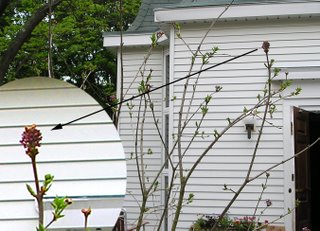 But there, right at the tip of about half the branches, were tiny blooms!
But there, right at the tip of about half the branches, were tiny blooms!
She may be nearly half a year behind her sibs across the driveway, and she may look puny to other folk, but to me she's simply gorgeous. You can be sure I spend time with her every day, still watering, and touching, and speaking words of praise to her.
She has become one of my teachers. Hang in there, no matter how hopeless you feel, she says. If you're yanked out of your comfortable home, leaving most of your roots behind, just sit tight in your new digs. New life may appear when you least expect it, and it will be all the sweeter for the surprise of it. Rough treatment certainly is no picnic, but you may find out you are tougher than you think. And don't worry too much if your neighbors seem to be more beautiful than you are; there is someone in the world who will love you to pieces, just the way you are.
I decided this plant was in the wrong place, snuggled up in the corner by the kitchen porch—not enough sun, too much wind, and stiff competition from the forsythia. So I moved it about fifteen feet west, where it could get good sun, now that ten of the twelve hemlocks once crammed into that space are gone. And when the chapel doors stand open in the summer, it would provide a lovely view. So with about half an hour to kill one afternoon, I tackled the move.
Wrong plan.
Lilac root balls are impressively large and deeply buried. Once committed, I had to get the job done, so I just got what I could of the root ball, dug the deepest hole possible (not nearly deep enough), in the remaining few minutes I had, and hoped for the best.
When this bush budded out with her parking lot neighbors in January, I was thrilled. She had made it! What stamina. But in April, when the rest of the crew was bursting with color and perfume, this little one just sat there with the same tiny buds she had produced months earlier. Uh-oh.
Every day I visited her, made sure she had enough water, checked her limbs for any sign of life, sang to her and convinced myself that there was suppleness just under my fingertips. Let's give her another week before pronouncing her past hope. Every day when I examined the little buds, I told myself something was happening there. Truth to tell, I just couldn't face the fact the I may have killed this little bush myself. Please, God, don't let me be a murderer this late in my life.
Then, a few weeks ago, there it was, the proof I had been watching and praying for all that time. No doubt about it now, there was green appearing at the bud tips. Oh, wow; we both had been reprieved.
But a few days later, I got a bigger surprise. This bush hadn't flowered in the three years since I moved here, so I assumed moving it would mean no blooms for several years more.
 But there, right at the tip of about half the branches, were tiny blooms!
But there, right at the tip of about half the branches, were tiny blooms!She may be nearly half a year behind her sibs across the driveway, and she may look puny to other folk, but to me she's simply gorgeous. You can be sure I spend time with her every day, still watering, and touching, and speaking words of praise to her.
She has become one of my teachers. Hang in there, no matter how hopeless you feel, she says. If you're yanked out of your comfortable home, leaving most of your roots behind, just sit tight in your new digs. New life may appear when you least expect it, and it will be all the sweeter for the surprise of it. Rough treatment certainly is no picnic, but you may find out you are tougher than you think. And don't worry too much if your neighbors seem to be more beautiful than you are; there is someone in the world who will love you to pieces, just the way you are.
Monday, May 22, 2006
Things Change
From days of rain to a day so clear your eyes hurt. Well, that's weather for you. I don't know why I fuss when things like weather appear to get stuck with the needle pointing to "lousy". In the first place, that's a pretty lopsided judgment to make—that rain is lousy and sunshine is wonderful. Actually, I love and appreciate them both, so what gives?
I think some needle deep inside me hangs up occasionally, pointing at lousy. Then I just look around and blame it on the nearest possibility. Like the weather.
But things are changing all the time, and if I could just unstick my own internal value monitor, I could avoid that gray, nasty, hopeless feeling that this (whatever "this" happens to be at the time) is just the way life will be forever. OK, maybe only for the foreseeable future, but when this happens, I'm not appreciating such distinctions.
Maybe I could remember this, instead: I went out to the rocky area beside the kitchen garden about a week ago to see how the new weed crop was going. That would be dandelions, plantain, wild violets, a few little ground-crawlers I haven't met yet, and some big dude that sports deep purple leaves all summer. That one was so pretty I actually watered it all last year, right along with the herbs.
But when I got out there, the only returners were the dandelions and violets. Where the little ground cover and plantain once shoved rocks aside were plants I've never seen there before. There are two huge docks, for example (a large critter that looks a lot like rhubard early on). And a bunch of smaller greenies; I have no idea at all what they are. The big purple dude? No sign of him yet, but there's nothing in his place, so I'm still hoping.
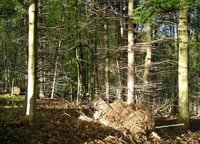 Then I started checking father afield. The front "yard", the back meadow, the hill from the driveway to the playing field; they are all home to plants that weren't there last year, at least not the way they are this. Wild chives and wild onions are really popular (we eat both). It's back to my plant book again to find out who else has joined the Bluestone Farm family.
Then I started checking father afield. The front "yard", the back meadow, the hill from the driveway to the playing field; they are all home to plants that weren't there last year, at least not the way they are this. Wild chives and wild onions are really popular (we eat both). It's back to my plant book again to find out who else has joined the Bluestone Farm family.
Yep. Things are changing all the time. Enjoy whatever is under my nose right now, because sooner or later it will surely change. I just need to remember that.
I think some needle deep inside me hangs up occasionally, pointing at lousy. Then I just look around and blame it on the nearest possibility. Like the weather.
But things are changing all the time, and if I could just unstick my own internal value monitor, I could avoid that gray, nasty, hopeless feeling that this (whatever "this" happens to be at the time) is just the way life will be forever. OK, maybe only for the foreseeable future, but when this happens, I'm not appreciating such distinctions.
Maybe I could remember this, instead: I went out to the rocky area beside the kitchen garden about a week ago to see how the new weed crop was going. That would be dandelions, plantain, wild violets, a few little ground-crawlers I haven't met yet, and some big dude that sports deep purple leaves all summer. That one was so pretty I actually watered it all last year, right along with the herbs.
But when I got out there, the only returners were the dandelions and violets. Where the little ground cover and plantain once shoved rocks aside were plants I've never seen there before. There are two huge docks, for example (a large critter that looks a lot like rhubard early on). And a bunch of smaller greenies; I have no idea at all what they are. The big purple dude? No sign of him yet, but there's nothing in his place, so I'm still hoping.
 Then I started checking father afield. The front "yard", the back meadow, the hill from the driveway to the playing field; they are all home to plants that weren't there last year, at least not the way they are this. Wild chives and wild onions are really popular (we eat both). It's back to my plant book again to find out who else has joined the Bluestone Farm family.
Then I started checking father afield. The front "yard", the back meadow, the hill from the driveway to the playing field; they are all home to plants that weren't there last year, at least not the way they are this. Wild chives and wild onions are really popular (we eat both). It's back to my plant book again to find out who else has joined the Bluestone Farm family.Yep. Things are changing all the time. Enjoy whatever is under my nose right now, because sooner or later it will surely change. I just need to remember that.
Friday, May 19, 2006
Raining again
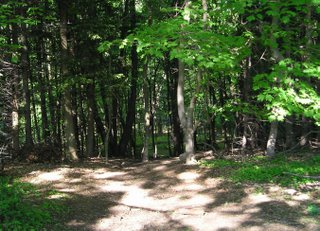 It's pouring rain again today, so I just have to put some sunny photos under my nose. Here we have yet another view of the woods with the morning sun. I find our woods enchanting. Fairy tales were written with such views in mind.
It's pouring rain again today, so I just have to put some sunny photos under my nose. Here we have yet another view of the woods with the morning sun. I find our woods enchanting. Fairy tales were written with such views in mind.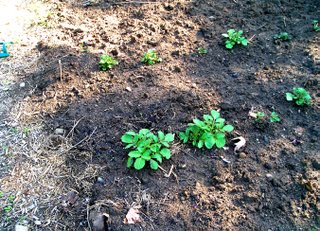
And then we have ... potato plants!! Last year it seemed to be in late June or early July before these plants made their appearance, but here it is, mid-May, and voila, potato wannabes.
No preachy lesson this time. Just a chance to share in the beauty of the Farm.
Got real milk?
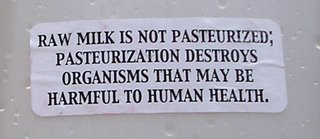
I was less than happy to see this sticker on a recent raw milk purchase. This is the result of our powerful dairy lobby, hard at work.
The message appears to be offered in the spirit of health-consciousness, but it is actually there in the interest of business. As in huge agri-business, factory farming, petroleum-dependent food production. The motive here is profit, not protection.
The truth is that raw milk is loaded with goodies that are beneficial to mammalian bodies. If you're not allergic to milk and want to drink it, raw's the way to go. Why? Because milk (obtained from grass-fed cows), when it has been properly gathered and safely stored and transported, is quite healthy. For example, some of the enzymes that raw milk contains actually assist the body in processing the fat in the milk. And the fat itself is healthy. If you're interested in the truth about raw milk, take a look at this brochure, produced for the Campaign for Real Milk (Weston A. Price Foundation, Washington, DC). Here's just one sentence from that brochure that should set you to thinking:
"Pasteurization destroys enzymes, diminishes vitamin content, denatures fragile milk proteins, destroys vitamins C, B12 and B6, kills beneficial bacteria, promotes pathogens and is associated with allergies, increased tooth decay, colic in infants, growth problems in children, osteoporosis, arthritis, heart disease and cancer."Sr. Claire Joy remarked this morning that pasteurization is like chemotherapy. I started to laugh, then we suddenly realized that it is chemotherapy. The process is violent (milk is quickly heated, especially in ultra-pasteurization, which takes less than two seconds) and destroys all the friendly, healthy contents as well as the rare bad booger in its path.
Then more chemistry is applied: scary-sounding stuff like oxidized cholesterol, neurotoxic amino acids, mucopolysaccharides, colorings, and bioengineered enzymes ... none of which even touch the antibiotics, hormones and pesticides that find their way into a cow's body, all in the name of increased milk production. The treatment of high-production animals, the destruction of small farms and farmers, and the dangers of genetically-engineered additives are each rich fodder for an entire blog of its own.
Yes, this is definitely a preachy entry, and for that I apologize. But I'm willing to take on just about any epithet if it helps awaken even one person to the dangerous "food" that lines our grocery store shelves, and to spurious marketing ploys that promise us health but give us junk.
Thursday, May 18, 2006
They're here!!
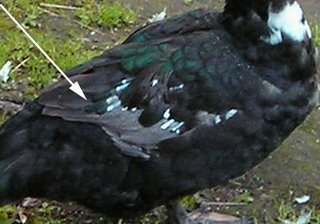 For all you duck lovers out there (and those of you who just tolerate my frequent duck-gushing blogs), all the hard work of the past two weeks is finally paying off!
For all you duck lovers out there (and those of you who just tolerate my frequent duck-gushing blogs), all the hard work of the past two weeks is finally paying off!Because the ducks aren't fond of close scutiny, and therefore waddle away when I try to take their pictures, these aren't the best ... but I think you can still see those amazing new little feathers, just pushing out of recently-naked quills. Petra is at the top, and her new, perfectly formed tiny wing feathers are that lovely blue-green-gold that marks a healthy feeding environment.
Basil, below, is even harder to catch on film, but his blossoming white wing feathers are fairly obvious in this shot.
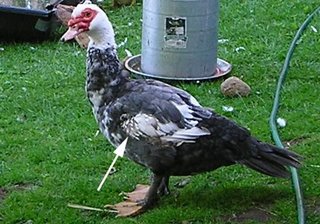 Spring is bustin' out all over!!
Spring is bustin' out all over!!(And stay tuned for more pics tomorrow. The garden has already begun its own fecundity; we will have our first salad of the spring for lunch today.)
Abundance
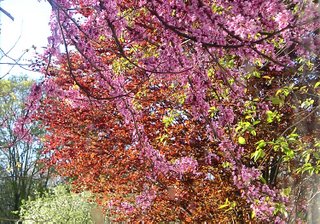 This spring has a wildness about it I don't remember seeing before. Everything is sporting an eye-popping lushness. My theory is that the harsh winter (and perhaps the more reserved production of several prior years) has something to do with this year's extravagance. Then again, it might just be something cyclical in the nature of an ecosystem.
This spring has a wildness about it I don't remember seeing before. Everything is sporting an eye-popping lushness. My theory is that the harsh winter (and perhaps the more reserved production of several prior years) has something to do with this year's extravagance. Then again, it might just be something cyclical in the nature of an ecosystem.I really don't know, but I am certainly enjoying the show. This picture was taken from our kitchen window early in May. The pink blossoms front and center are on the redbud tree; the bright green leaves to the right are on the wild cherry tree just behind the redbud. Across the driveway is the ancient and always gorgeous copper beech, which displays a variety of red leaves from early spring to late fall. In the lower left corner is a dogwood that is actually behind the main building, and behind that is one of our many maples, just beginning to wave its own green signs of spring.
The view changes constantly. A few days ago the redbud began to exchange its deep pink beauty for wide green heart-shaped leaves, and will soon receive its first pruning in some years. The wild cherry is beginning to build its own blossoms: right now they are tiny green buds that look a lot like the cherries that will appear toward the end of the growing season, but soon they will appear as banana-like clumps of small white flowers. The copper beech leaves are beginning to darken, and the dogwoods are tossing their delicate petals to the ground in wild abandon. The azalea and lilac bushes are so prolifically decked out this year they are actually bending their branches toward the ground.
And it's not just this eye-candy thing going on; for some time the heady perfume of lilac blooms has saturated the air. Every day sisters, teachers, students and bees jockey for position to drink in that smell. (Okay, I know the bees are doing a little more than smelling, but you get the idea.)
I'm trying to figure out how all this works. A lot of animals and birds and insects are either waking up or showing up, most of them hungry. Do the showy colors and smell attract them in ways they wouldn't figure out on their own? I mean, really, is all this necessary?
I know nothing is wasted in a healthy ecosystem, but I'm convinced the beauty surrounding us is both necessary and gratuitous. Something changes inside me when the lilacs bloom. One deep breath, and I'm back in 1954 or so, lying down under another lilac, a nine-year-old transported to lilac heaven. I can see that same dozey look on the other adults as they take their turn at the purple blooms. Lilacs have a gentle "power" over most of us.
It might work for the birds and bees and every other hungry soul to be attracted to one color, or one smell, or one shape for that matter. It could have been that way ... but it's not. Our Universe seems intent on variety, and its living systems are built to enjoy that wild abundance, whether we're eating, or smelling or remembering.
I'm so glad.
Tuesday, May 16, 2006
Birdsong
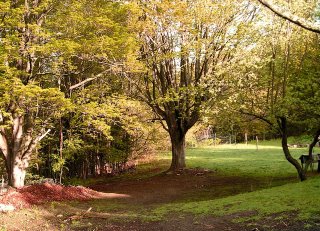 Its about time for a picture. But it has been raining for the best part of ten days now, and that doesn't provide the best picture-taking opportunities. So here is one from just before this long rainy stretch began. There's no reason for this particular picture; I just like the look of this Grandmother Maple.
Its about time for a picture. But it has been raining for the best part of ten days now, and that doesn't provide the best picture-taking opportunities. So here is one from just before this long rainy stretch began. There's no reason for this particular picture; I just like the look of this Grandmother Maple.Its hard to say for sure, but I think morning is my favorite at this time of year. The sunlight slanting into the trees is especially inviting. As you can see from this shot, the four directions circle in the back yard is wonderfully illuminated, while the rest of the meadow waits its turn for the light of day.
But what I love most is the birdsong. It's mesmerizing. I'm slowly learning who's who out there by the sounds they make. Cardinals, blue jays, chickadees, mourning doves, a whole raft of sparrows, bluebirds, robins, crows, woodpeckers, nuthatches, phoebes, tufted titmice and many I have yet to identify.
My all-time favorite bird call comes from the thrush family, though. We have both wood and hermit thrushes in the woods nearby, and their clear, flute-like melodies stand out like the Big Dipper in the night sky.
Identifying birds from their song can be quite a challenge. Try it: pick out one sound from all the rest, remember it, and then go search the internet for an audio clip that matches it. It's sort of like trying to use a dictionary to find the correct spelling of a word. And in the spring, birdcalls change quite a bit, as mating and nesting songs are added to the variety of sounds any one bird produces.
This is one of those times when it's quite obvious we need each other. Those thrushes, for example, are difficult to spot. They are shy, for one thing, and by the time they appear in our neighborhood, the trees are already decked out in their lush summer garb, making bird-spotting all but impossible. On the other hand, bluejays are not only raucous singers (though "yelling" is more like it), but they also hang around in plain sight, stealing the duck food every chance they get.
I only know about the thrushes because I sat on a bench near another wood several years ago, joined by someone I hardly knew. We were attending a conference. She was an older, reserved woman, and we sat quietly together, listening. "OH!! Did you hear that??" she said suddenly. "That's a hermit thrush!" She said it with hushed awe, and I knew were were hearing something very special. It took awhile for me to pick out the sound, but she was patient, and fortunately the little bird hung around, singing its heart out for some time. Once I could isolate its beautiful lilting voice, I knew I would never forget it.
That's what we do for each other; we sit together, listening, and we help one another sort out the voices of the world. The next time someone shares her wisdom with you, thank her—and remember to pass it along.
The "Habits" of the Universe
We are studying Swimme and Berry's The Universe Story in chapel each day, reading one paragraph at a time and using the structure of the African Bible Study model to explore, ponder, discover, and challenge ourselves to delve into this amazing place in which we live.
Today it was about the "habits" of the Universe: the four basic forces of gravity, electro-magnetic, strong nuclear and weak nuclear. These four immutable actions determine relationship and interraction throughout the Universe, and though we rarely think about it, they determine how we live our lives in minute detail.
But what caught my attention was the instant before those forces coallesced into existence. In the primordial moment, there was no gravity, no electromagnetism, no strong and weak nuclear forces. There weren't any atoms or quarks, either, and I can't even begin to imagine what "time" and "space" meant at that point.
Just as I cannot grasp the concept of time or space having a beginning point, I can't wrap my limited brain around the idea of "pre-gravity". In the beginning the flaring forth was wildly chaotic—an exploding soup of heat and light and infinite possibility. And almost instantly, in Universe time, that soup differentiated into forces and particles, and the infinite span of future possibilities narrowed dramatically.
There is something about our Universe that yearns toward organization—not to the exclusion of ongoing creativity, certainly, but that "leaning into" the creation of determined structures is clearly there. Our Universe seems to prefer building its unique body on a skeleton of predicability.
So I guess it shouldn't surprise me that I have the tendency toward organization as well. I have a definite penchant for neatness and clear space; I am driven by a-place-for-everything-and-everything-in-its-place thinking. I can't be creative when surrounded by personal chaos. In fact, I find it hard to breathe in a chaotic environment. (Perhaps literally: the dust bunnies under my bed were beginning to grow teeth and develop language.)
So I spent most of yesterday implementing my own laws of structure in the mini-universe of my bedroom/office space. I know my sisters find my leaning into organization annoying (on their best days), but I prefer to think of it as echoing the nature of the Universe. Of setting structure into place so that creativity can blossom forth. Of living in harmony with the basic nature of the Universe.
Yeah, that's the ticket.
Today it was about the "habits" of the Universe: the four basic forces of gravity, electro-magnetic, strong nuclear and weak nuclear. These four immutable actions determine relationship and interraction throughout the Universe, and though we rarely think about it, they determine how we live our lives in minute detail.
But what caught my attention was the instant before those forces coallesced into existence. In the primordial moment, there was no gravity, no electromagnetism, no strong and weak nuclear forces. There weren't any atoms or quarks, either, and I can't even begin to imagine what "time" and "space" meant at that point.
Just as I cannot grasp the concept of time or space having a beginning point, I can't wrap my limited brain around the idea of "pre-gravity". In the beginning the flaring forth was wildly chaotic—an exploding soup of heat and light and infinite possibility. And almost instantly, in Universe time, that soup differentiated into forces and particles, and the infinite span of future possibilities narrowed dramatically.
There is something about our Universe that yearns toward organization—not to the exclusion of ongoing creativity, certainly, but that "leaning into" the creation of determined structures is clearly there. Our Universe seems to prefer building its unique body on a skeleton of predicability.
So I guess it shouldn't surprise me that I have the tendency toward organization as well. I have a definite penchant for neatness and clear space; I am driven by a-place-for-everything-and-everything-in-its-place thinking. I can't be creative when surrounded by personal chaos. In fact, I find it hard to breathe in a chaotic environment. (Perhaps literally: the dust bunnies under my bed were beginning to grow teeth and develop language.)
So I spent most of yesterday implementing my own laws of structure in the mini-universe of my bedroom/office space. I know my sisters find my leaning into organization annoying (on their best days), but I prefer to think of it as echoing the nature of the Universe. Of setting structure into place so that creativity can blossom forth. Of living in harmony with the basic nature of the Universe.
Yeah, that's the ticket.
Monday, May 15, 2006
The Raccoon Wars
We're at war again. Oh, we're not about guns and smart-bombs (isn't that an oxymoron?) and terrorizing our Earthly neighbors—we're just trying to figure out a way to keep the raccoons out of the duck and bird feed storage. It's a war of mind and skill, not murder.
All winter we keep the feed in metal garbage cans outside on the porch. No problem. But with the riotous explosion of spring, the raccoons awaken and are famished. In additional to a ravenous appetite, they also have extremely clever brains and opposable thumbs. A raccoon is a formidable competitor, even for humans.
So instead of a simple push on the lids at night, we placed a cement paver on top. That worked until the raccoons were actually awake. The first signs that they were completely conscious was that the plastic liner, which hung (notice the past tense) over the lip of the can and down its side, was shredded in the morning, the lid was off and the the food supply noticeably lowered. No problem, we'll use the bungee cords. We don't mind sharing a bit; we like to think of ourselves as good neighbors, after all.
Two short cords, threaded through the lid handle and secured (ha) on the can handles should do the trick. "Should", maybe, but raccoons can't read. Off came the cords and down went the food. My "good neighbor" attitude vanished. Enough of feeding those little bandits.
The next night I twisted the cement paver into the cords and stretched them tight. With a great deal of effort, I also managed to wedge a good-sized log under the cords as well. I wasn't sure I'd be able to get in the next morning, but I knew I'd sleep soundly that night.
I did, but the 'coons didn't. I can just imagine the sniggering as they surrounded the can. "Look at this!!" [Snort-snort.] "Oh, those humans. What an entertaining bunch! But so stoooopid. OK, guys, let's do it." Chomp-chomp. BANG goes the cord as they chew through. I doubt if even one of them got clonked in the head in the process. "RESTAURANT OPEN!" one hollers to the waiting hordes. Down goes the food.
That's it, Jodi declares. The food goes down to the basement. I agree. I'm pretty sure the raccoons can't get into the house (though it wouldn't surprise me if they have a key to the door stashed somewhere). OK, so we'll schlep food cans up and down stairs every day for the rest of the summer. I can use the exercise.
But this morning I decided to google (great verb, hunh?) "animal-proof cans" and found something even a grizzly bear couldn't break into. Big old twist-top lid. Slippery, killer-thick poly construction—they could even bounce it down the steps and not get to the food. Only $49.95. Plus shipping and handling.
I almost did it. But then it occurred to me: grizzlies don't have opposable thumbs.
All winter we keep the feed in metal garbage cans outside on the porch. No problem. But with the riotous explosion of spring, the raccoons awaken and are famished. In additional to a ravenous appetite, they also have extremely clever brains and opposable thumbs. A raccoon is a formidable competitor, even for humans.
So instead of a simple push on the lids at night, we placed a cement paver on top. That worked until the raccoons were actually awake. The first signs that they were completely conscious was that the plastic liner, which hung (notice the past tense) over the lip of the can and down its side, was shredded in the morning, the lid was off and the the food supply noticeably lowered. No problem, we'll use the bungee cords. We don't mind sharing a bit; we like to think of ourselves as good neighbors, after all.
Two short cords, threaded through the lid handle and secured (ha) on the can handles should do the trick. "Should", maybe, but raccoons can't read. Off came the cords and down went the food. My "good neighbor" attitude vanished. Enough of feeding those little bandits.
The next night I twisted the cement paver into the cords and stretched them tight. With a great deal of effort, I also managed to wedge a good-sized log under the cords as well. I wasn't sure I'd be able to get in the next morning, but I knew I'd sleep soundly that night.
I did, but the 'coons didn't. I can just imagine the sniggering as they surrounded the can. "Look at this!!" [Snort-snort.] "Oh, those humans. What an entertaining bunch! But so stoooopid. OK, guys, let's do it." Chomp-chomp. BANG goes the cord as they chew through. I doubt if even one of them got clonked in the head in the process. "RESTAURANT OPEN!" one hollers to the waiting hordes. Down goes the food.
That's it, Jodi declares. The food goes down to the basement. I agree. I'm pretty sure the raccoons can't get into the house (though it wouldn't surprise me if they have a key to the door stashed somewhere). OK, so we'll schlep food cans up and down stairs every day for the rest of the summer. I can use the exercise.
But this morning I decided to google (great verb, hunh?) "animal-proof cans" and found something even a grizzly bear couldn't break into. Big old twist-top lid. Slippery, killer-thick poly construction—they could even bounce it down the steps and not get to the food. Only $49.95. Plus shipping and handling.
I almost did it. But then it occurred to me: grizzlies don't have opposable thumbs.
Sunday, May 14, 2006
Our Mother(s)
My biological mom died twenty years ago, but Mother's Day still stirs the memory of her as if she were still here, home with Dad in their little house in Kentucky. Her last years weren't her best; she couldn't remember our names or who were were in the family hierarchy. When we gathered for our folks' fiftieth wedding anniversary, she ate butter for dinner and insisted that I pour her wine exactly to the top of the glass.
When I finally managed to push the limits of surface tension in the glass, she settled down to playing with her blouse buttons, and ignored the rest of us (and the overfilled wine glass) completely. It was the last time I remember seeing Mom dressed and in a normal setting.
She wasn't always that way, of course. When my sister and I were in our early teens, we got a wild hair to make mudpies one rainy day. Mom surprised us by hauling out the wheelbarrow and joining in the messy fun. I must have looked bewildered when she rounded the corner of the house with that wheelbarrow, because she said to me, "This is the last time I'll see my children playing in the mud. I don't want to miss it."
Moms come in all shapes and sizes and with a wild variety of personalities and parenting skills. I've been a mom, too, and it's not all that easy. Loving your children is the joyful, natural and practically brainless part. It's raising them well that makes your stomach ache and sprouts the gray hair. Most of us manage to botch the job thoroughly on occasion, even with the best of intentions.
There is something about that tension between maternal loving and living—tenderness bound by steel—that draws me in. A child enters your life and for years afterward you live in the chaos of trying to shape them safely into their future without destroying their uniqueness, and mostly you can't figure any of it out in advance. Basically you really don't know how you're doing until your chance to change it is long past.
I often think Mother Earth is suffering a similar angst with her human children. We are filled with possibilities, eager to try every new thing that catches our attention, convinced we will live forever, blind to the messes we make in the process of growing up.
So, Happy Mother's Day — to you, Mom, wherever you may be, and to you, Mother Earth. Both of you gave me life, and sheltered me, and fed me, and tried your best to see that I grew into a compassionate, responsible, happy adult. I hope you are thinking all that effort was worth it.
When I finally managed to push the limits of surface tension in the glass, she settled down to playing with her blouse buttons, and ignored the rest of us (and the overfilled wine glass) completely. It was the last time I remember seeing Mom dressed and in a normal setting.
She wasn't always that way, of course. When my sister and I were in our early teens, we got a wild hair to make mudpies one rainy day. Mom surprised us by hauling out the wheelbarrow and joining in the messy fun. I must have looked bewildered when she rounded the corner of the house with that wheelbarrow, because she said to me, "This is the last time I'll see my children playing in the mud. I don't want to miss it."
Moms come in all shapes and sizes and with a wild variety of personalities and parenting skills. I've been a mom, too, and it's not all that easy. Loving your children is the joyful, natural and practically brainless part. It's raising them well that makes your stomach ache and sprouts the gray hair. Most of us manage to botch the job thoroughly on occasion, even with the best of intentions.
There is something about that tension between maternal loving and living—tenderness bound by steel—that draws me in. A child enters your life and for years afterward you live in the chaos of trying to shape them safely into their future without destroying their uniqueness, and mostly you can't figure any of it out in advance. Basically you really don't know how you're doing until your chance to change it is long past.
I often think Mother Earth is suffering a similar angst with her human children. We are filled with possibilities, eager to try every new thing that catches our attention, convinced we will live forever, blind to the messes we make in the process of growing up.
So, Happy Mother's Day — to you, Mom, wherever you may be, and to you, Mother Earth. Both of you gave me life, and sheltered me, and fed me, and tried your best to see that I grew into a compassionate, responsible, happy adult. I hope you are thinking all that effort was worth it.
Friday, May 12, 2006
Duck Feathers
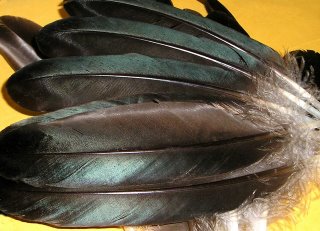 Let me begin by acknowledging that I have been more than remiss in my blogging. I have many good and valid reasons, but I won't bother trotting them out, because I know everyone can produce a "good" excuse when she needs one, and the rest of us don't think too much of it.
Let me begin by acknowledging that I have been more than remiss in my blogging. I have many good and valid reasons, but I won't bother trotting them out, because I know everyone can produce a "good" excuse when she needs one, and the rest of us don't think too much of it.OK, then, let's talk about ducks. (This one's for you, Lynne.) We have been wading through duck feathers for a couple of weeks now. I can't seem to find a reliable source of information that can tell me how much longer this may last, but it seems to be somewhere between two more weeks and maybe next November.
In the meantime, I pick up several dozen discarded feathers a day, with hundreds more passed by. Our three older ducks (that would be Basil, Macrina and Petra) are molting.
Oh, boy, are they molting.
I've never experienced this before (nor have these particular ducks), and I am definitely impressed. Everything else in duck life is put on hold in the effort to be decked out in a new feathery spring outfit: no eggs, no wandering about the neighborhood, no mating ... just feather-dropping and feather-making. Though I admit I don't really see much evidence of that feather-making part just yet.
It's really sad.
The ducks are looking shabby; everything from the teeniest pin feathers to impressive wing- and tail-tips are scattered around the yard and in the duck houses. Looks like a major pillow fight happens daily out there. All three ducks wander about with little feathers hanging on by a thread and bigger ones hanging off their bodies every which way.
It never occurred to me that some (all?) birds need to change clothes every year or so, and that it takes a humongous effort to do it.
I pick up the least damaged feathers and look at them carefully. The big female feathers are half brown and half blue-green-gold, separated by a deep burgundy quill. On one side of their body the shiny part is on the right side of the feather; on the other side of the body, it's on the left. The feathers arc in opposite directions, too. The base of every feather begins with about 1/2" of boa-like wisps, soft and fluffy shafts that curl and float in every direction. Then, suddenly, perfectly formed shafts "glue" themselves to each other and form the part of the feather we recognize as "feather".
Hunh. Never noticed that before.
I've also discovered that each duck has an extensive feather inventory—from 1/2" to 10" long, each an exactly formed feather, from boa-fluff to tip. Needless to say, no two feathers are exactly alike. Makes you wonder how a duck looks coherent, doesn't it?
But if we were to take such a careful look at any creature, whether bird, mammal, insect, rock or brussels sprout, we'd discover similar characteristics. Now that is amazing. All our pieces-parts are quite individual and completely unique, yet when viewed as a whole, a bird is percieved as a bird, not as a conglomeration of a few thousand feathers; a lion is a lion, not a bunch of different kinds of hair and nails and teeth; a mountain is a mountain, not a scree field here, a schist out-cropping there ...
Think about it. Doesn't that just make your jaw drop in wonder?
Subscribe to:
Posts (Atom)

